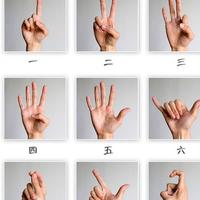#5: 数字 手势
number 1|gesture
|gesto
número|gesto
#Nr. 5: Numerische Gesten
#5: Digital Gestures
#5: Gestos digitales
#5 : Gestes numériques
#5: Gesti digitali
#5位:デジタルジェスチャー
# 5: Цифровые жесты
#5: Numeriska gester
中国 的 数字 手势 和 其他 国家 的 不 一样 , 中国 人数 数 的 时候 , 手 就是 字 。
|||gesture|with|other||||different||the number of people|1|||||
|||||||||||pessoas||||mão||
||número|||||||||número de personas|数|||||
China's digital gestures are different from those of other countries. When the number of Chinese people is small, the hand is the word.
我 的 朋友 张孜帮 我 拍 了 下面 的 一组 照片 , 通过 这些 照片 , 我 告诉 你 中国 人 怎么 用手 指数 数 。
|||Zhang Zibang|||||||||||||||||use hands||
|||Zhang Zibang||||||un grupo|||||||||||mano|índice|
|||Zhang Zibang||tirar||abaixo||um conjunto||através de|||||||||com a mão|指|número
My friend Zhang Wei took the following set of photos for me. Through these photos, I told you how the Chinese indexed by hand.
对 了 , 首先 要 弄清楚 , 每根 手指 的 名字 。
||||aclarar||||
||primeiro||entender|cada|dedo||nome
By the way, the first thing to do is to figure out the name of each finger.
D'ailleurs, il faut d'abord trouver le nom de chaque doigt.
从 最 粗 的 手指 开始 , 五根 手指 分别 叫做 : 大拇指 、 食指 、 中指 、 无名指 和 小拇指 , 小拇指 也 叫 小指 。
||||||||||thumb|index finger|middle finger|||pinky||||
||grueso||dedo|comenzar|cinco||separadamente||pulgar|||||||||
a partir de||grosso||dedo|começar|cinco||respectivamente||dedão|índice|médio|anelar||dedinho|dedinho|||dedinho
Starting from the thickest finger, the five fingers are called: thumb, index finger, middle finger, ring finger and little finger, the little finger is also called the little finger.
En partant du doigt le plus épais, les cinq doigts s'appellent le pouce, l'index, le majeur, l'annulaire et l'auriculaire, qui est également appelé le petit doigt.
一 、 握拳 , 竖起 食指 就是 “ 一 ”。
|fist clenched|levantar|indicador||
1\. Make a fist and raise your index finger is "one".
二 、 在 “ 一 ” 的 基础 上 , 再 竖起 中指 , 就是 “ 二 ”。
||||base||||||
2\. On the basis of "one", raise the middle finger again, which is "two".
三 、 可以 在 “ 二 ” 的 基础 上 , 再 竖起 无名指 ; 也 可以 像 表示 “OK” 的 手势 那样 : 大拇指 压住 食指 , 竖起 另外 三根 手指 。
|||||||||||||||||||press down|||||
|||||base||||||||indicar|||gesto|||pressiona|índice|erguer|outros|três|dedos
||||partícula possessiva||||||||||||||||||||
Third, you can erect the ring finger on the basis of “two”; you can also like the gesture of “OK”: The thumb presses the index finger and erects three other fingers.
我 更 喜欢 第二种 , 因为 做 起来 比较 容易 。
|||segunda|||fazer||
I prefer the second one because it is easier to do.
四 、 大拇指 压在 手掌心 , 竖起 其他 四根 手指 。
||pressiona|palma da mão|||quatro|
4\. Press your thumb on the palm of your hand and raise the other four fingers.
五 、 竖起 所有 手指 就是 “ 五 ”, 简单 吧 。
Five, erect all the fingers is "five", simple.
六 、 做 一个 打电话 的 手势 : 握拳 后 , 伸出 大拇指 和 小指 。
|||||gesto|||estender|||
6\. Make a call gesture: After making a fist, stretch your thumb and little finger.
七 、 大拇指 、 食指 和 中指 在 说 悄悄话 , 这 就是 “ 七 ”。
|||||em||conversa em segredo|||
7\. The thumb, forefinger and middle finger are whispering, this is the "seven."
八 、 握拳 , 伸出 大拇指 和 食指 。
Eight, clenched fists, stretched out the thumb and index finger.
这个 手势 就 像 一把 枪 , 我 觉得 它 有点像 颠倒 的 汉字 “ 八 ”。
||||uma|arma||||é um pouco像|invertido||caractere chinês|
This gesture is like a gun. I think it is a bit like the inverted Chinese character "eight."
Le geste ressemble à un pistolet, et je pense que c'est un peu comme le caractère chinois "huit" à l'envers.
九 、 握拳 , 伸出 食指 , 然后 弯曲 180 度 。
nove|fechar a mão||||curvar|graus
Nine, make a fist, stretch out the index finger, and then bend 180 degrees.
Serrez le poing, tendez l'index et pliez-le à 180 degrés.
我 觉得 “ 九 ” 的 手势 应该 是 阿拉伯数字 “9” 颠倒 后 的 样子 。
|||||||número árabe||||
I think the "nine" gesture should be the reverse of the Arabic numeral "9".
十 、 握拳 就是 “ 十 ”。
Ten, the fist is the "ten."
所以 , 一只 手 握拳 , 另外 一只 手 表示 一个 数字 , 两只手 一起 就 可以 表示 20、30、40, 直到 90; 另外 一种 表示 “ 十 ” 的 手势 是 : 两只手 的 食指 交叉 , 这 就是 汉字 “ 十 ”。
então||mão|||||indica|||duas mãos|||||até||||||||duas mãos|||cruzadas||||
Therefore, if one hand makes a fist and the other hand represents a number, the two hands together can represent 20, 30, 40, until 90; another gesture to represent "ten" is: the index fingers of the two hands are crossed, which It is the Chinese character "ten".
Par conséquent, une main serre le poing et l'autre main représente un nombre, et les deux mains ensemble peuvent représenter 20, 30, 40 et jusqu'à 90 ; un autre geste pour représenter "dix" est : les index des deux mains sont croisés, ce qui représente le caractère chinois "dix".
我 觉得 这比 第一种 手势 更加 准确 。
||isso|primeira||mais|preciso
I think this is more accurate than the first gesture.
Je pense qu'il est plus précis que le premier geste.

